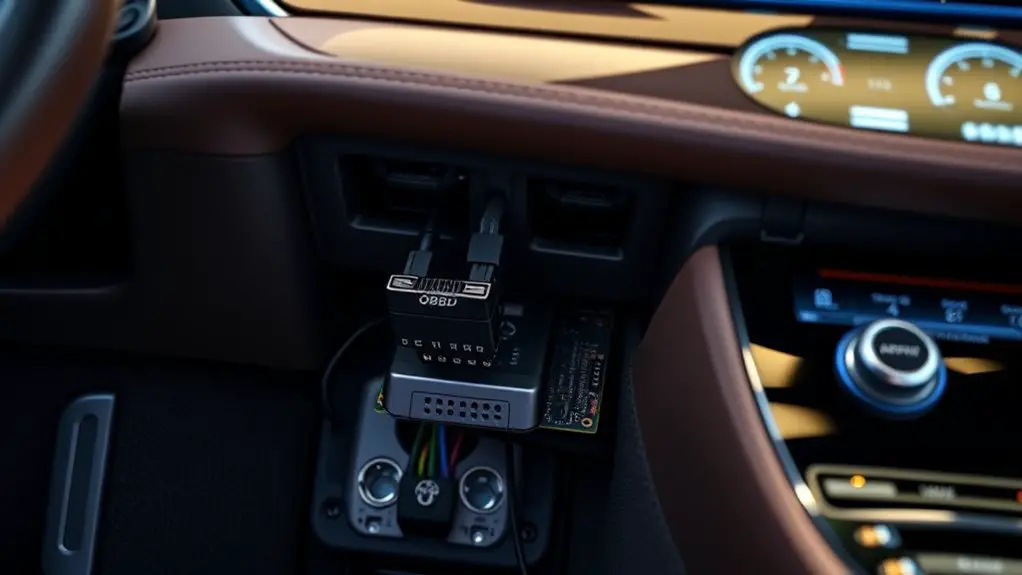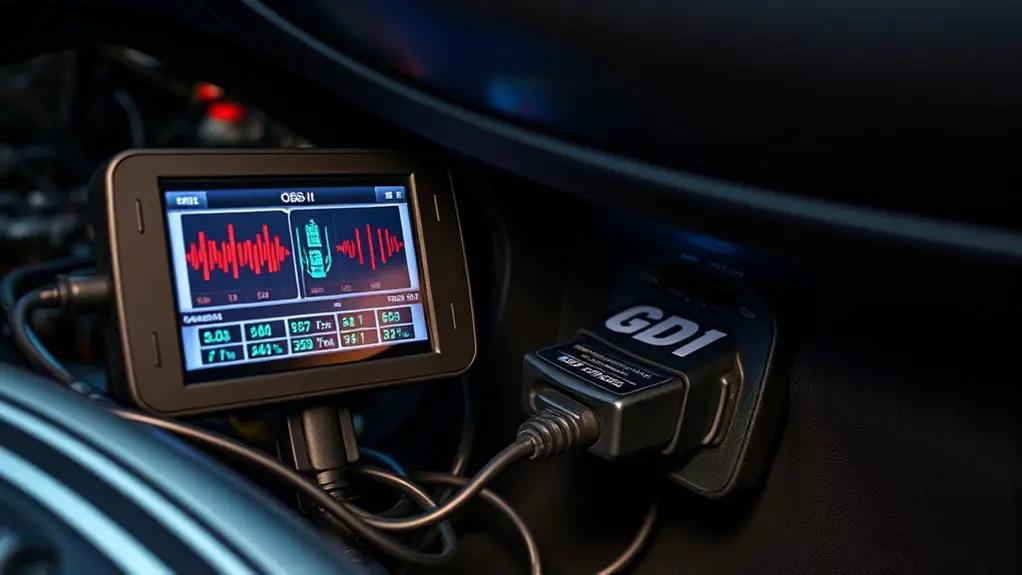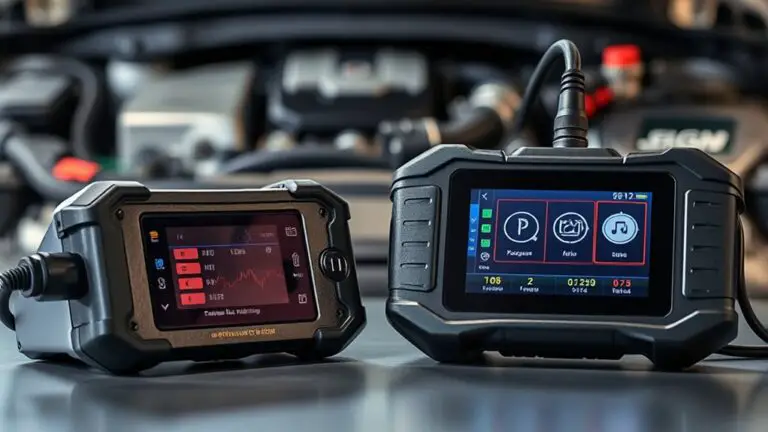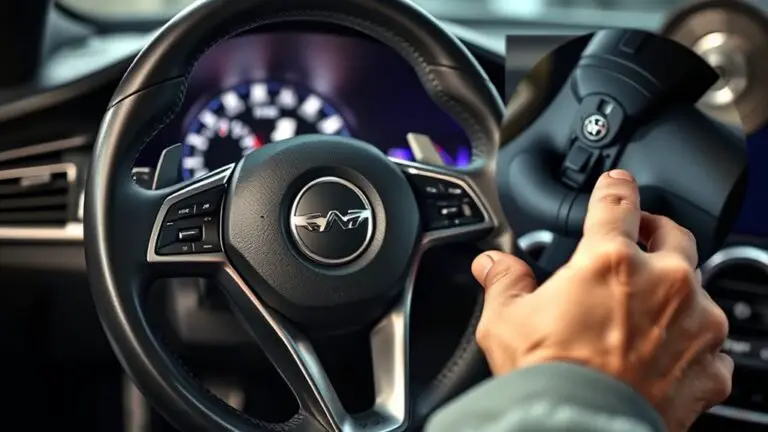How to Interpret Lack of Diagnostic Info When Scanning a Modern OBD-II Cars
Modern OBD‑II scans can look sparse because modern cars gate data behind controllers, guardrails, and mixed protocols. You’re getting reliability signals, not a full fault map. Expect data fragmentation, latency, and brand‑specific schemas that hide or delay transient faults. Check power, grounds, and fuses first, then verify the tool, connector, and protocol settings. Compare sessions and baselines across known good vehicles. If you still see little detail, you’ll uncover more insights as you continue exploring the system.
Causes for Sparse OBD-II Readouts in Modern Cars

Sparse OBD-II readouts in modern cars can stem from a combination of data availability, controller design, and user expectations. You’ll find that data access is bounded by ECU roles, factory software, and implemented privacy guards, meaning not every parameter is streamed or logged. Sensor calibration affects what can be reported; out-of-range or recently adjusted sensors may sit outside standard diagnostic thresholds, reducing usable codes. Communication protocols between the vehicle’s networks and the OBD-II port may limit polling frequency, filtering, or translation of raw signals into standard PIDs, yielding sparse results even when faults exist. In some designs, manufacturers prioritize essential health data or emissions compliance over full diagnostic granularity, which tempers what you can retrieve. You should also consider vehicle age and firmware updates, which can change which data paths are active. Expect variability across brands, models, and markets, but base expectations on documented OBD-II capabilities and your vehicle’s service information.
How Vehicle Architecture Impacts Diagnostic Data

Vehicle architecture shapes what data you can access and how it’s exposed. Modern ECUs and networks create data silos and mixed protocols that can limit visibility without specialized tooling. Recognizing these structural barriers helps you interpret why diagnostic information seems sparse or fragmented.
Modern Architecture Effects
Modern vehicle architectures shape what diagnostic data is available and how it’s accessed. You’ll notice that architecture choices, like centralized vs. distributed controllers, shift data location, timing, and granularity. These shifts reflect modern design and automotive trends, not personal fault. You must account for how buses, protocols, and ECUs constrain visibility and access, shaping what you can reliably diagnose.
- You’ll encounter data latency that challenges real-time troubleshooting.
- You’ll see fragmented streams requiring correlation across modules.
- You’ll face vendor-specific schemas that limit universal interpretation.
- You’ll benefit from standardized interfaces while acknowledging exceptions.
Stay precise: rely on evidence from OEM documentation, measured response times, and cross-vehicle comparisons to guide your interpretation. This clarity empowers you to pursue accurate diagnostics within evolving architectures.
Data Access Barriers
Architectures shape not just what data exists but how you can access it. Data access barriers in modern OBD-II cars arise from layered control modules, security measures, and vendor-specific interfaces that gate diagnostic flows. You’ll encounter data accessibility gaps when dashboards, telematics, or advanced driver-assistance systems filter or obscure fault codes, engine parameters, and event data. Diagnostic limitations aren’t just about a missing P-code; they reflect permission models, protocol fragmentation, and firmware protections that curb raw data availability. Evidence shows manufacturers increasingly privilege in-house apps and authorized tools, reducing third-party visibility. To navigate, map which modules hold relevant data, validate interfaces, and verify what is officially accessible. Awareness of these barriers helps you assess faults responsibly while preserving your right to informative, actionable findings.
OEM Data Guardrails and Their Effect on Codes

OEM data guardrails shape how codes are generated, filtered, and surfaced to the user, balancing fault visibility with safety and data integrity. You’ll notice that OEM limitations constrain fault reporting to meaningful, actionable items, not every raw sensor blip. The result is a clearer diagnostic surface that prioritizes reliability over noise, yet may obscure some granular data you might want for in-depth analyses. Data encryption protects sensitive vehicle and ownership information, but it also shapes how accessible certain codes are across tools and vendors. You should expect standardized codes to be consistent within the brand, even when similar issues appear across models. Be mindful that guardrails can delay or modify fault visibility during transient events. To navigate this, consider cross-checking with boot-time or live-param logs where permitted.
- You gain focus on truly critical faults.
- You accept access trade-offs for security.
- You rely on manufacturer-aligned interpretations.
- You pursue transparent, tested workflows.
Distinguishing Real Faults From False Alarms
You’ll learn to weigh whether a fault code really reflects a tightening of engine control or a fleeting sensor glitch. By comparing diagnostic gaps with known failure patterns, you can separate real faults from false alarms with evidence-based checks. This starts with clear criteria for when an alert warrants action versus when it should be monitored.
Real Vs False Alarms
Real-world diagnostics on OBD-II systems often hinge on separating true faults from false alarms, since misread codes can stem from sensor quirks, temporary glitches, or data sampling issues rather than an actual mechanical problem. You’ll want a disciplined workflow to quantify risk before you replace parts or reset codes.
1) Confirm the fault persists across multiple drives and modes.
2) Cross-check with live data against baseline norms to spot anomalies.
3) Validate the code’s absence after a reset to rule out intermittent signals.
4) Correlate with symptoms, performance changes, and previous repair history to distinguish real alarms from false alarms.
Interpreting Diagnostic Gaps
Interpreting diagnostic gaps requires a disciplined approach to separate genuine faults from benign data voids or intermittent signals. When you encounter missing or delayed codes, rely on structured diagnostic interpretation: correlate gaps with known failure modes, sensor drift, or communication timeouts rather than assuming a defect. Document the context, vehicle speed, load, and recent repairs, then compare observed gaps to baseline behavior for your model. Prioritize corroborating evidence—cross-check MIL status, freeze-frame data, and live sensor reads during fault windows. Use error code analysis to distinguish transient glitches from persistent issues, noting repeatability and severity. By maintaining rigorous criteria and avoiding assumption-driven leaps, you improve diagnostic accuracy while preserving your freedom to pursue non-invasive verification.
Interpreting Blank or Incomplete Scan Totals
When scan totals are blank or incomplete, it usually means the diagnostic tool didn’t fetch all requested data or the vehicle’s CAN bus didn’t respond consistently. You’re not imagining gaps—you’re seeing real limits in what the scan can capture.
To navigate this, consider these facts:
1) scan tool limitations
2) error code interpretation
3) connection quality and protocol compatibility
4) vehicle network load and ECU responsiveness
These factors shape what you can trust. If totals aren’t shown, confirm tool settings, verify proper adapters, and retry with a stable connection. Compare results across different scan sessions and, when possible, test on a known-good vehicle to establish a baseline. Document which modules respond and which don’t, reducing ambiguity. Remember, blank totals aren’t proof of no faults; they signal incomplete data that require methodical verification rather than assumption. Your goal is precise, evidence-based interpretation, not guesswork.
Strategies to Improve Scan Quality and Clarity
To improve scan quality and clarity, start by verifying tool and connector basics—confirm the adapter type, baud rates, and protocol settings, then re-run with a stable connection to reduce data gaps. You’ll minimize noise that clouds results, making interpretation more reliable. Prioritize scan tool selection that supports your vehicle’s protocol and provides transparent logging. Favor devices with verified performance in real-world conditions, not just specs. Verify cables are intact, connectors are clean, and grounding is solid to cut stray signals that distort data frames. When possible, enable high-resolution logging and timestamped data blocks to improve traceability. Apply data interpretation techniques that separate transient glitches from meaningful patterns—compare repeat runs, note consistent PID responses, and watch for alignment between sensor data and actuator states. Document your setup and any anomalies to support reproducibility. Freedom in your process comes from disciplined methods, not guessing; precision yields meaningful insights and faster decisions.
Practical Steps for Narrowing Down Issues
Building on what you’ve done to improve scan quality, practical steps for narrowing down issues focus your effort on isolating the root cause with repeatable tests. You’ll use diagnostic tools and proven scanning techniques to verify hypotheses, not guesswork, ensuring conclusions are evidence-based.
Define a single failure mode, reproduce it, and test with repeatable diagnostics to prove root cause.
- Define a single failure mode and reproduce it under controlled conditions.
- Swap or isolate components to confirm whether the fault follows a part or a system boundary.
- Log repeated measurements over time to distinguish intermittent faults from transient noise.
- Cross-verify with alternate data sources (live data, freeze frame, and ECU logs) to corroborate findings.
Apply these checks in a disciplined loop: hypothesize, test, observe, document. Maintain neutrality of data, avoid premature conclusions, and prioritize safety. The goal is a clear, repeatable narrative that guides repairs without ambiguity, using diagnostic tools and scanning techniques to support every decision and preserve your freedom to work confidently.
What to Do When You Still Can’t Get Useful Info
Even so, if useful data remains elusive, you’ll tighten the approach by tightening your data sources and tests rather than broadening hypotheses. When diagnostics stall, switch to targeted diagnostic tools and well-validated scan techniques to reframe the problem. Begin by verifying that the basics are sound: power, grounds, and fuses, then confirm the battery and alternator health before re-testing sensors. If the car’s computer stores no fault codes, consider live data streams from multiple ECU channels and compare against known-good baselines for your model. Use manufacturer-specific measurements when available, not generic proxies. Document each step, noting anomalies, timing, and environments that correlate with symptoms. If issues persist, isolate subsystems one at a time and repeat scans under controlled conditions. Finally, consult service literature and peer-tested forums for technique refinements rather than assuming hidden faults. This disciplined approach preserves freedom by relying on repeatable, evidence-based methods.
Frequently Asked Questions
Why Do Scanners Sometimes Show No Codes After a Drive Cycle?
When you see no codes after a drive cycle, it might be scanner limitations or the car hasn’t completed the required criteria yet. Drive cycle implications vary by vehicle and system, so you may need another complete cycle or different tests. You should verify that the scanner supports all OBD-II modes you care about, and recheck after a proper cycle. If issues persist, consider professional diagnostics to avoid false negatives.
Can OEMS Completely Block Diagnostic Data From Tools?
Yes, OEMs can severely limit diagnostic data via restrictions, but they cannot render all tools useless. Data privacy and OEM restrictions shape what you access, yet core diagnostic capabilities remain: shop-grade scanners with proper access, vehicle-specific protocols, and evolving tool compatibility. You’ll see varied data availability across brands. If a tool isn’t supported, you may still retrieve basic fault codes and live data with compliant, documented interfaces—freedom to diagnose grows with broad, standards-based access.
Do All Modules Report Equally Across Brands and Models?
No, not all modules report equally across brands and models. You’ll see module compatibility vary, with some brands delivering broader data sets than others. Brand differences matter: certain manufacturers limit what you can access, while others expose more fault codes and live data. To gauge this, compare supported services, and test across vehicles you own. Rely on documented OBD-II extensions and user reports to choose tools that maximize compatibility for your needs.
How Often Do Software Updates Unlock Hidden Diagnostic Data?
Software updates rarely reveal major, universal data overnight; improvements are incremental. You’ll typically see diagnostic thresholds refined and software improvements that expose previously obscured codes, but not every vehicle gains new data with each release. Expect occasional revelations tied to OEM-specific access, and remember that access varies by brand. If you want freedom, track update notes, test relevant modules, and verify that new data actually informs repairs before counting it as revealed significance.
Are There Legal Ways to Bypass Data Access Restrictions?
There aren’t legal ways to bypass data access restrictions. You’ll face legal implications if you attempt to circumvent protections, even for autonomy or freedom aims. If you need diagnostic data, pursue manufacturer-supported channels, OBD-II interfaces, or authorized third-party tools. Data access is governed by licenses, warranties, and regional laws, and exploiting gaps can void warranties or violate regulations. For legitimate use, document your purpose, seek consent, and rely on evidence-based, compliant methods.






